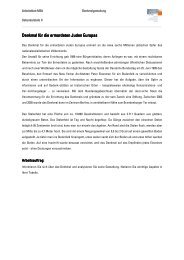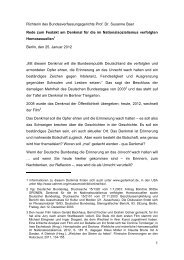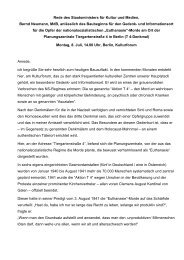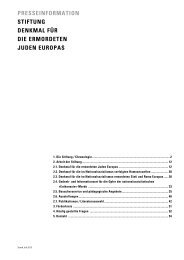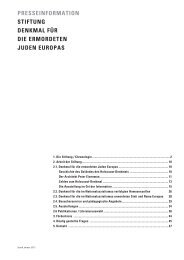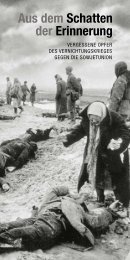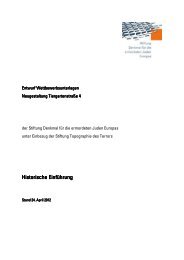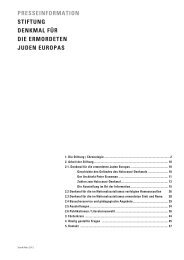Walerjan Wróbel - Stiftung Denkmal für die ermordeten Juden Europas
Walerjan Wróbel - Stiftung Denkmal für die ermordeten Juden Europas
Walerjan Wróbel - Stiftung Denkmal für die ermordeten Juden Europas
You also want an ePaper? Increase the reach of your titles
YUMPU automatically turns print PDFs into web optimized ePapers that Google loves.
Children and Youth as<br />
Victims of the Nazi Crimes<br />
Seventy years ago, the National Socialists came to<br />
power in Germany. During their rule, which lasted<br />
until 1945, they persecuted and terrorized human<br />
beings because of their origin, religion or physical<br />
or mental handicap. The National Socialists attacked<br />
many countries in Europe, occupied them and<br />
murdered many millions, including six million Jews<br />
from across Europe. On this web site, we wish to<br />
remember five young people who became victims<br />
of Nazi terror.<br />
<strong>Walerjan</strong> <strong>Wróbel</strong><br />
from the Polish village of Falków<br />
1925 –1942<br />
www.stiftung-denkmal.de
<strong>Walerjan</strong>, under arrest in 1941. He was<br />
photographed by the headquarters of<br />
the Criminal Police in Bremen.<br />
Source: State archive Bremen<br />
<strong>Walerjan</strong> <strong>Wróbel</strong><br />
<strong>Walerjan</strong> <strong>Wróbel</strong> was born on April 2, 1925 in the<br />
Polish village of Falków. He had a younger brother<br />
and sister. His carefree childhood came to an abrupt<br />
end with the German invasion of Poland in<br />
September 1939. Five days after the beginning of<br />
the war, many houses in his village, including that<br />
of his parents, were destroyed in a bombing raid.<br />
After that, most of the families lived in the ruins or<br />
found shelter with relatives. At this time, many Poles<br />
were deported to work as forced laborers in<br />
Germany. <strong>Walerjan</strong> was also sent to Germany in<br />
April 1941 at the age of 16 to work in forced labor 1<br />
on a farm near Bremen. A few days after arrival,<br />
he was already terribly homesick. He attempted to<br />
flee but was caught.<br />
<strong>Walerjan</strong> <strong>Wróbel</strong> Page 1 www.stiftung-denkmal.de
The farm near Bremen where <strong>Walerjan</strong><br />
was forced to work as a farmhand.<br />
Photographed in 1942 by the Bremen<br />
Criminal Police. Source: State archive Bremen<br />
<strong>Walerjan</strong> <strong>Wróbel</strong><br />
<strong>Walerjan</strong> was brought back to the farm. He<br />
immediately began to make plans to return home<br />
in a different way. He thought that if he proved to<br />
be a poor worker, his penalty would be that he<br />
would be fired from the job. In despair, he decided<br />
to set a fire in order to be sent back home to his<br />
parents. Only a few days after his first attempt to<br />
escape, he set fire to some hay in a barn on the<br />
farm. The farmer’s wife discovered the fire right<br />
away before it could cause any damage. <strong>Walerjan</strong><br />
even helped her extinguish the blaze. Nonetheless,<br />
she reported the boy to the police for arson. After<br />
interrogation by the Gestapo 2 he was arrested on<br />
May 2, 1941. Until his arraignment in April 1942,<br />
he was confined as a prisoner in the Neuengamme 3<br />
concentration camp.<br />
<strong>Walerjan</strong> <strong>Wróbel</strong> Page 2 www.stiftung-denkmal.de
Michal about his friend <strong>Walerjan</strong>:<br />
»Walerek [Walerek is a nickname for <strong>Walerjan</strong>] was very young, very naïve. He didn‘t<br />
have any experience either. He was so naïve: if you told him that something was true,<br />
or that this is the way it was in the camp, he believed you right away. He would believe<br />
anything. It‘s rough for people like that in the concentration camp, very difficult.<br />
I mean, you have to be brutal there, not naïve. And Walerek was always naïve, very naïve.<br />
He always talked about his parents, his sister, he’d talk about school.«<br />
<strong>Walerjan</strong>’s friend Michal Piotrowski, whom he met in Neuengamme<br />
concentration camp. The photo is of Michal in 1940 at the age of 17<br />
when he was confined in Auschwitz concentration camp.<br />
Source: Halina Piotrowska, Warsaw<br />
<strong>Walerjan</strong> <strong>Wróbel</strong><br />
In the Neuengamme camp 3 , <strong>Walerjan</strong> was deployed<br />
for nine months in exhausting manual labor in a<br />
punishment platoon. He was in the so-called Elbe<br />
platoon that was assigned to construct a canal four<br />
to five kilometers in length from the Neuengamme<br />
camp to the Dove Elbe river. Inmates were often<br />
forced to stand all day long in deep mud in order to<br />
straighten the canal banks. Others had to cart off<br />
the soil removed in heavy wheelbarrows. Many <strong>die</strong>d<br />
of exhaustion and the poor living conditions.<br />
<strong>Walerjan</strong> found a friend among the prisoners,<br />
Michal Piotrowski. Michal was only two years older<br />
than <strong>Walerjan</strong> and also came from Poland. Michal<br />
survived the war and later told a journalist about<br />
<strong>Walerjan</strong> and his story.<br />
<strong>Walerjan</strong> <strong>Wróbel</strong> Page 3 www.stiftung-denkmal.de
Bremen, July 9, 1942<br />
Bremen.<br />
Dear Mom and<br />
dear Dad,<br />
brother and little sister.<br />
Last words.<br />
<strong>Walerjan</strong> <strong>Wróbel</strong>.<br />
<strong>Walerjan</strong> painted this horse for his<br />
parents and enclosed it with his farewell<br />
letter, July 1942.<br />
Source: Neuengamme Concentration Camp Memorial<br />
<strong>Walerjan</strong> <strong>Wróbel</strong><br />
On April 8, 1942, almost one year after the fire in<br />
the barn, <strong>Walerjan</strong> was remanded in custody to<br />
Bremen. A trial before a special court 4 was initiated<br />
to try him. Despite the fact that <strong>Walerjan</strong> was still<br />
a minor, the court found him guilty of arson and<br />
sentenced him as a »Volksschädling« 5 (lit. »pest<br />
harmful to the people«) to death. The day after he<br />
was sentenced he wrote a secret farewell letter to<br />
his parents. The letter was successfully smuggled<br />
out of the prison and sent to his family.<br />
<strong>Walerjan</strong> <strong>Wróbel</strong> Page 4a www.stiftung-denkmal.de
Denial of the plea for mercy by<br />
Roland Freisler, Berlin 1942.<br />
Source: State archive Bremen<br />
<strong>Walerjan</strong> <strong>Wróbel</strong><br />
<strong>Walerjan</strong>’s public defender submitted a plea for mercy, denied by<br />
Roland Freisler 6 in the name of the Reich justice minister. <strong>Walerjan</strong><br />
was executed in Hamburg on August 25, 1942 at the age of 17.<br />
The carrying out of the death penalty was announced publicly in order<br />
to serve as a deterrent and warning to the population in Bremen.<br />
In the 1980s, a historian came upon <strong>Walerjan</strong>’s story and investigated it,<br />
publishing the findings of his research in a book. Today an association<br />
for the indemnification of former forced laborers bears the name of<br />
<strong>Walerjan</strong> <strong>Wróbel</strong>.<br />
To inform the public about <strong>Walerjan</strong>’s execution, posters were pasted up<br />
in Bremen at more than 250 places. They referred to <strong>Walerjan</strong><br />
euphemistically as an agricultural worker, but in actual fact he had been<br />
deported to Germany as a forced laborer. Source: State archive Bremen<br />
<strong>Walerjan</strong> <strong>Wróbel</strong> Page 4b www.stiftung-denkmal.de
Translation of Freisler´s denial:<br />
Certified Copy<br />
In the criminal case at the Special Court in Bremen<br />
on 8 July 1942 against<br />
<strong>Walerjan</strong> W r o b e l<br />
found guilty of arson and sentenced to death as<br />
a pest dangerous to the people, I have decided, by and on<br />
authority of the Führer, not to grant him a pardon, but<br />
rather to let justice take its course.<br />
Berlin, 15 August 1942<br />
Reich Minister of Justice<br />
(seal) Signed Dr. Freisler (on behalf of the minister)<br />
----<br />
Certified as identical with the original:<br />
Berlin, 17 August 1942<br />
(seal)<br />
[signed] Chief Secretary, Ministerial Chancellery<br />
<strong>Walerjan</strong> <strong>Wróbel</strong><br />
Translation of the notice on walerjan´s death sentence:<br />
<strong>Walerjan</strong> <strong>Wróbel</strong> Page 4b Translation www.stiftung-denkmal.de<br />
Notice<br />
On Aug. 25, 1942<br />
<strong>Walerjan</strong> Wrobel<br />
born on April 2, 1925, was executed, pursuant to a death<br />
sentence handed down by the Special Court in Bremen.<br />
Wrobel, a Polish agricultural worker, set fire to a German farm.<br />
Bremen, August 25, 1942<br />
Chief State Prosecutor, Head of Prosecution at the Special Court
Forced Labor<br />
Immediately after the German invasion of Poland in September 1939, there was a drastic deterioration in the living conditions<br />
of the Polish population. A large proportion of produced goods now had to be handed over to the German occupiers.<br />
The food which the German provided the Poles as rations was barely enough for survival. Widespread unemployment made<br />
their economic situation even worse. The consequences were starvation and destitution. A short time after the occupation<br />
began, Germans recruited Poles for work in the Reich. Many initially reported »voluntarily«, hoping in this way to assure their<br />
own survival. A short time later every village was forced to provide a specified number of workers for the German Reich.<br />
Down to 1941, most were deployed as farmhands in agriculture on German farms, but later were sent to work in large numbers<br />
especially in the armaments industry. Many were forced to live under conditions that resembled those in the concentration<br />
camps. Food and accommodations were often miserable, the working conditions frequently inhuman and even highly<br />
dangerous. The Nazis used the policy of forced labor in all the occupied countries in Europe. Down to the end of the war, some<br />
eight million persons were deported to Germany from all over Europe and exploited there as forced laborers.<br />
<strong>Walerjan</strong> <strong>Wróbel</strong> Background Text www.stiftung-denkmal.de
1 Forced Labor<br />
Even before the outbreak of the war, the labor offices organized forced labor for inmates in concentration camps, persons with previous<br />
convictions and welfare recipients. During the war, some eight million civilians, POWs, concentration camp prisoners and Jews from<br />
occupied Europe, including many youths who were still minors, were exploited as forced laborers in ca. 30,000 camps. They were<br />
also deployed in the German construction and armaments industry as well as in agriculture. Many perished as a result of the inhuman<br />
working conditions.<br />
2 Secret State Police (Gestapo, Geheime Staatspolizei)<br />
Established in 1933, placed in 1934 under Heinrich Himmler, Reichsführer-SS and Chief of the German Police. It was used to persecute<br />
political opponents. Without a court proceeding, the Gestapo handed down penalties, sentencing persons to imprisonment in jails and<br />
concentration camps; it murdered political prisoners, foreign forced laborers, and POWs. The Gestapo was directly implicated in the<br />
mass murder of the European Jews.<br />
3 Neuengamme Concentration Camp<br />
Built in 1938 near Hamburg, originally as a subcamp of Sachsenhausen concentration camp. In 1940, it became an independent camp<br />
with numerous auxiliary camps. Tens of thousands of prisoners from the occupied countries in Europe were confined in its perimeter,<br />
including many resistance fighters. The prisoners had to do forced labor. Almost every second inmate in Neuengamme <strong>die</strong>d. Five days<br />
before the end of the war, the SS loaded the approximately 7,000 remaining prisoners on a ship that was mistakenly attacked by the<br />
Allies (RAF) and sunk (Cap Arcona Tragedy).<br />
4 Special Court<br />
Established in 1933 for the speedy conviction of political prisoners. The accused had only limited rights, and there could be no appeal<br />
against a judgment handed down by these courts. From 1938 on, the competence of these courts was extended to include jurisdiction<br />
over all criminal offenses. Down to 1945 and the end of the war, some 11,000 death sentences were handed down by special courts<br />
against regime opponents, Poles, Jews and so-called Volksschädlinge.<br />
5 »Volksschädling« (lit. »Pest harmful to the people«)<br />
From 1939 on a term used for persons who voiced criticism of the Nazi regime. The concept was also employed for »misfits« who in<br />
the eyes of the Nazis harmed the »public welfare« of society, such as those involved in plundering after air-raids, etc. Initially a label<br />
used mainly for Germans, later it was also employed to characterize Poles. A person so labeled could be sentenced to the most severe<br />
punishment, in many cases the death penalty.<br />
6 Freisler, Roland<br />
Born in 1893 in Celle, <strong>die</strong>d 1945 in Berlin. A legal expert, from 1925 on member of the NSDAP. In 1932, he was elected a deputy in the<br />
Prussian House of Representatives in Berlin. In 1934, Freisler was appointed State Secretary in the Justice Ministry, and from 1942 served<br />
as President of the People’s Court. Under his jurisdiction, there was a severe restriction of the rights of the accused and numerous death<br />
penalties were handed down, in contradiction with any understanding of civil law. He was popularly known as the »blood judge«.<br />
Glossary<br />
<strong>Walerjan</strong> <strong>Wróbel</strong> www.stiftung-denkmal.de
Literature<br />
m Aly, Götz (Hrsg.): Herrenmensch und Arbeitsvölker. Ausländische Arbeiter und Deutsche 1939–1945,<br />
Beiträge zur Nationalsozialistischen Gesundheits- und Sozialpolitik 3, Berlin 1986.<br />
m Berliner Institut <strong>für</strong> Lehrerfort- und -weiterbildung und Schulentwicklung (Hrsg.):<br />
» ... <strong>die</strong> vielen Morde ...«. Dem Gedenken an <strong>die</strong> Opfer des Nationalsozialismus, Berlin 1999.<br />
m Freyberg, Jutta v., Barbara Bromberge, und Hans Mausbach: »Wir hatten andere Träume«.<br />
Kinder und Jugendliche unter der NS-Diktatur, Frankfurt am Main 1995.<br />
m Herbert, Ulrich: Fremdarbeiter: Politik und Praxis des »Ausländer-Einsatzes« in der Kriegswirtschaft<br />
des Dritten Reiches, Bonn 1999.<br />
m Hraber, Roman, Zofia Tokarz, und Jacek E. Wilczur: Kinder im Krieg – Krieg gegen Kinder:<br />
Die Geschichte der polnischen Kinder 1939–1945, Reinbek 1981.<br />
m Martin, Angela: Ich sah den Namen Bosch. Polnische Frauen als KZ-Häftlinge in der<br />
Dreilinden Maschinenbau GmbH, Berlin 2002.<br />
m Schminck-Gustavus, Christoph: Das Heimweh des <strong>Walerjan</strong> <strong>Wróbel</strong>.<br />
Ein Sondergerichtsverfahren 1941/42, Bonn 1986.<br />
m Spanjer, Rimco, Diete Oudesluijs, und Johan Meijer (Hrsg.): Zur Arbeit gezwungen.<br />
Zwangsarbeit in Deutschland 1940–1945, Bremen 1999.<br />
m Spoerer, Mark: Zwangsarbeit unter dem Hakenkreuz. Ausländische Zivilarbeiter, Kriegsgefangene<br />
und Häftlinge im Deutschen Reich und im besetzten Europa 1939–1945, München 2001.<br />
m Wassiljewa, Tatjana: Ab jetzt zählt jeder Tag, Weinheim, Basel 1994.<br />
Literature / Films / Links<br />
<strong>Walerjan</strong> <strong>Wróbel</strong> www.stiftung-denkmal.de
Films<br />
G »Das Heimweh des <strong>Walerjan</strong> <strong>Wróbel</strong>« (96 Min) Spielfilm, Deutschland 1990 (Regie: Rolf Schübel);<br />
Der Film erzählt <strong>die</strong> Verfolgungsgeschichte des <strong>Walerjan</strong> <strong>Wróbel</strong>.<br />
Erhältlich über Landesbildstellen oder Studio Hamburg, Postfach 101 560, 22039 Hamburg.<br />
G »Die Kinder von Himmlerstadt« (30 Min) Dokumentation, Deutschland 1983 (Regie: Elke Jonigkeit);<br />
Der Film erzählt über <strong>die</strong> Germanisierungspolitik der SS im Distrikt Lublin und das Schicksal der Kinder<br />
aus dem Gebiet Zamosc (Polen). Erhältlich über Landeszentralen <strong>für</strong> politische Bildung.<br />
Links<br />
E http://berliner-geschichtswerkstatt.de<br />
E http://www.lernen-aus-der-geschichte.de<br />
E http://www.spurensuche-harz.de<br />
E http://www.stu<strong>die</strong>nkreis-widerstand-1933-45.de<br />
E http://www.sujet.de/zwangsarbeit-berlin/<br />
E http://www.lwv-hessen.de<br />
E http://www.step21.de<br />
E http://www.erinnern-online.de<br />
Literature / Films / Links<br />
<strong>Walerjan</strong> <strong>Wróbel</strong> www.stiftung-denkmal.de
Research and text:<br />
Annegret Ehmann, Stefanie Fischer<br />
Editing:<br />
Stefanie Fischer<br />
Design:<br />
sujet.design Claudia Winter, Oliver Temmler<br />
Translator:<br />
Bill Templer<br />
Responsible for conception and layout:<br />
Prof. Dr. Sibylle Quack<br />
We are especially grateful to the following persons and institutions:<br />
Richard Cossmann, Gymnasium Herborn, Germany<br />
Laura Dostmann, Seifertshofen, Germany<br />
Federal Archive Berlin-Lichterfelde, Germany<br />
Hadamar Memorial, Germany<br />
Sonja Haderer-Stippel, Austria<br />
Gottfried Kößler, Fritz Bauer Institut, Frankfurt am Main, Germany<br />
Bertil Langenohl, Max-Ernst-Gymnasium of the city of Brühl, Germany<br />
Anna Matthias, Kaltenkirchen, Germany<br />
Memorial, Concentration Camp Neuengamme, Germany<br />
Lidice Memorial, Czech Republic<br />
Municipality of Hadamar, Mayor’s Office, Mr. Lanio, Germany<br />
Halina Piotrowska, Poland<br />
Scheuern Homes, Nassau / Lahn, Germany<br />
Prof. Christoph Schminck-Gustavus, Bremen, Germany<br />
State Archive Bremen, Germany<br />
Prof. Karl and Anna Stojka, Austria<br />
© <strong>Stiftung</strong> <strong>Denkmal</strong> <strong>für</strong> <strong>die</strong> <strong>ermordeten</strong> <strong>Juden</strong> <strong>Europas</strong>, 2003<br />
Web Site Credits<br />
<strong>Walerjan</strong> <strong>Wróbel</strong> www.stiftung-denkmal.de




